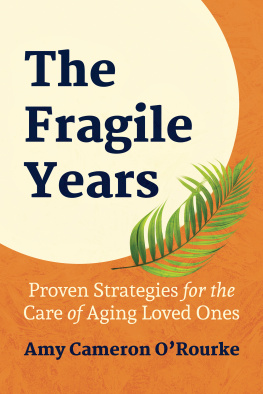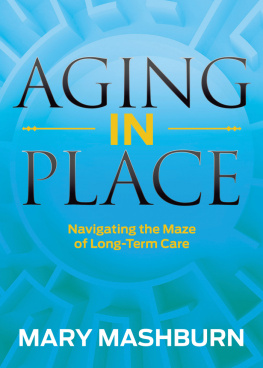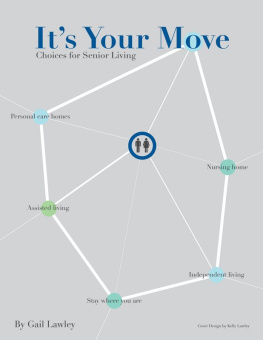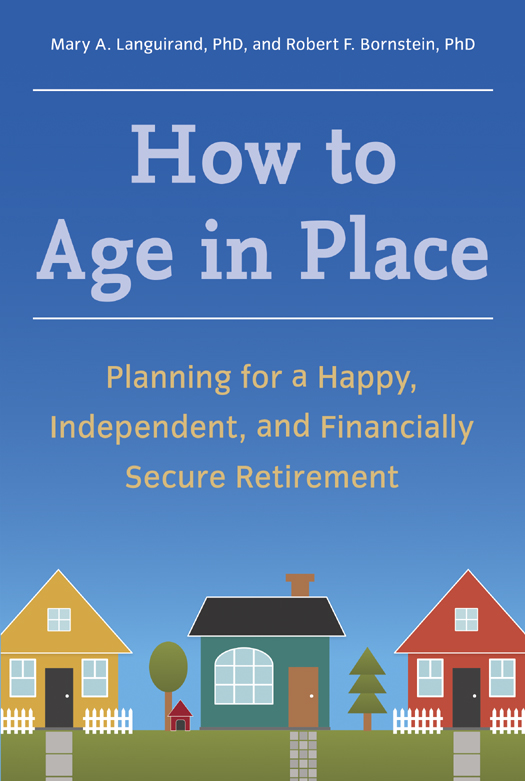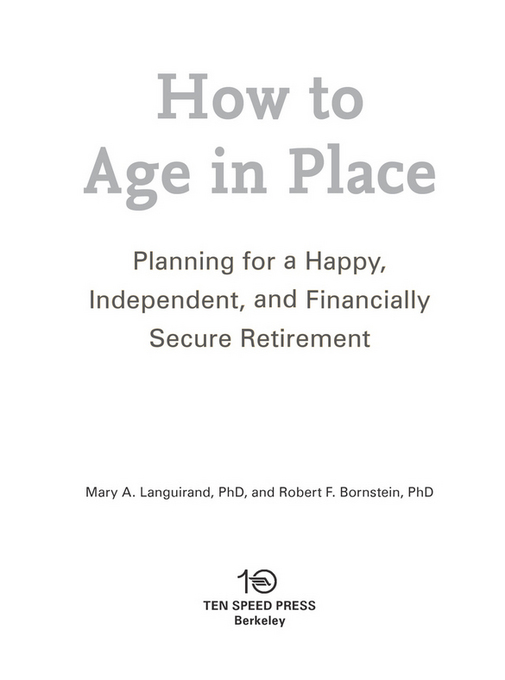In memory of Sam and Maggie Mudd,
for making it look easy
Copyright 2013 by Robert F. Bornstein and Mary A. Languirand
All rights reserved.
Published in the United States by Ten Speed Press, an imprint of the Crown Publishing Group, a division of Random House, Inc., New York.
www.crownpublishing.com
www.tenspeed.com
Ten Speed Press and the Ten Speed Press colophon are registered trademarks of Random House, Inc.
Library of Congress Cataloging-in-Publication Data
Languirand, Mary A.
How to age in place : planning for a happy, independent, and financially secure retirement /
Mary A. Languirand, PhD and Robert F. Bornstein, PhD. First Edition.
pages cm
1. RetirementPlanning. I. Bornstein, Robert F. II. Title.
HQ1062.L36 2013
306.38dc23
2013005502
eISBN: 978-1-60774-417-7
v3.1
Contents
Acknowledgments
Wed like to thank a number of people who contributed greatly to this project. First and foremost, we are grateful to our agent, Joelle Delbourgo, whose support and enthusiasm over these past twelve years has been unwavering, and who helped us transform our ideas into something tangiblethe book youre now holding in your hands. Wed also like to thank Julie Bennett, who had faith in our vision and signed the project, supporting us all the way. And special thanks to Emily Timberlake, whose insightful comments, questions, and suggestions helped turn How to Age in Place into a compelling, engaging text.
Several other members of the Ten Speed Press team made key contributions to this effort and taught us a great deal along the way. Wed like to thank Colleen Cain for her inspirational design, which complements and supports the theme of our book, and Kara Van de Water, Michele Crim, and Patricia Kelly for their invaluable contributions to publicity and marketing, helping us reach a broad and diverse readership. We are grateful to Jean Blomquist and Molly Woodward for copyediting and proofreading our sometimes challenging text, and to Ken Della Penta for providing an index that we know will serve our readers well.
Introduction
HOW WILL YOU SPEND YOUR RETIREMENT YEARS?
Kate and Tom prided themselves on being careful planners, especially when it came to something as important as retirement. They decided to retire earlyTom from his job as a professor, Kate from hers as a social workerand since both were Civil War buffs, they bought a home in Gettysburg, Pennsylvania, near the battlefield. They decided to purchase an older housea fixer-upperbut it was worth it because they loved the old-fashioned fireplaces, rough-hewn wood floors, antique leaded glass, and beautiful carved banisters.
Kate and Tom saved diligently for retirement and had accumulated a sizable nest egg. Now that they were living off savings rather than income, they decided to invest their funds conservatively, so they put most of their assets into a variable annuity. All went well for the first couple of years, and between trips to antique fairs and visits from their grandchildren, Kate and Tom were having the time of their lives. They went a little overboard here and there upgrading the house and property, but this was the place the kids would have forever, so it seemed money well spent.
Then the unexpected happened: Kate had a stroke. She was paralyzed on the left side. With hard work in rehab Kate recovered much of her function, but she remained wheelchair-bound and required the assistance of home health aides 24/7. A good long-term care insurance policy helped cover the costs, which was a blessing (not all long-term care policies actually cover in-home care).
As Kate worked toward recovery, problems began to emerge. Because it was an older house, there was no bath or shower on the ground floor. The doorways were too narrow to accommodate a wheelchair, and the kitchen was so small that Kate couldnt enter it at all. She was essentially a prisoner of the living roomnot a good situation for someone with her busy, active personality. They explored the possibility of installing a ramp for Kate to enter and leave the house, and a lift to get her up and down the stairs, but the price of retrofitting the home was substantial.
When the stock market tanked in 2008, the monthly income from their variable annuity went from $4,000 to less than $2,400. Because they were not yet fully vested in the annuity (this typically takes anywhere from six to ten years), Kate and Tom were unable to access their funds without incurring a substantial early-withdrawal penalty. At this point, they could no longer make their mortgage payments; they were forced to sell their house at a loss. Tom moved in with their daughter and her husband, and he went back to work part-time to help cover the bills. Kate entered a nursing home. The happy retirement that Kate and Tom had long envisioned was gone.
Have you ever met anyone who wanted to spend their retirement years relying on others for help and support? Of course not. Kate and Tom certainly didnt. Like Kate and Tom, most of us plan to live at home, doing what we please, free to live out those long-deferred dreams that were put off in favor of work and raising a family.
If most of us would like to spend our retirement years at home, why dont we? Sometimes the reasons are unavoidable. Poor health may require round-the-clock nursing care; cognitive decline from Alzheimers disease or other factors may make independent living impossible. But sometimes people cant live at home not because of health problems, but because they fail to plan aheadthey dont do the things they need to do to maintain their independence and age in place.
What Is Aging in Place?
Aging in Place is a national movement aimed at enabling older adults to remain in their own homes by making available the social support, health care, and home maintenance services that people need to live safe, happy, productive lives in the community. Aging in place may mean continuing to live where you have lived for many years, or moving to a new residence (or new locale) that maximizes your ability to live independently.
Aging in place involves confronting some practical issues. If left undone, these issues can interfere with independent living:
Financial planning
Safe housing
Neighborhood safety and walkability
Accessibility of services (a pharmacy, for example, or nearby grocery store)
Proactive medical and mental health care
Opportunities for community, cultural, and civic engagement
Sustainability to ensure long-term cost effectiveness
Beyond the practical issues, aging in place represents a philosophical shifta social movementwhich includes:
Developing a new vision of healthy aginga new attitude regarding needs of people in their 70s, 80s, and 90s, and the myriad ways in which older adults can contribute to society
Creating innovative, efficient models of eldercare services that make aging in place economically viable for the individual and society
As you can see, aging in place requires some planning. But arranging those services that will enable you to live independently, safely, and comfortably, and stay active and engaged throughout your retirement, will help make aging in place the new normal.
Kate and Tom: What Went Wrong?


